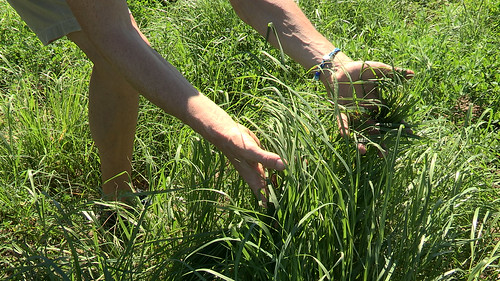Alfalfa stands benefit from interseeding with annual grasses
By the U of A System Division of Agriculture
June 30, 2017
Fast Facts:
- Thinning alfalfa stands can be interseeded w/forages to extend stand life
- Annuals, such as teff and Italian ryegrass, work well for the southeastern U.S.
- An especially useful strategy in glyphosate-resistant alfalfa stands
(465 words)
(Download this story in MS Word here.)
LITTLE ROCK – Ranchers and other landowners growing alfalfa, whether for forage or as a cash crop, are likely familiar with the high environmental pressures insect pests and disease that accompany warm and humid summers.
Even in the best of circumstances, alfalfa stands tend to thin out over time, and growth during summer months is typically reduced, said Dirk Philipp, Associate Professor of Forages with the University of Arkansas System Division of Agriculture.
However, recent research from Philipp and other researchers has shown that annual forages can be interseeded in fall or spring with other grasses, including Italian ryegrass and teff can complement alfalfa’s dry matter production and forage quality.
“This is especially useful in herbicide-resistant alfalfa as this leaves the option of cleaning up any undesired plants in the process,” Philipp said. “That’s where the interseeded forages come in: they provide increased dry matter production without a substantial loss in forage quality.”
Teff is a cereal crop from northern Africa, but can also be grown as fast-growing summer forage crop. Italian ryegrass is a leafy and nutrition cool season grass from Europe. Both species can keep up with the vigorous growth of alfalfa.
During the first year of Philipp’s research trial, teff contributed relatively more dry matter to the overall growth than Italian ryegrass with a maximum of 30 percent for teff mid-summer, and 10 percent for ryegrass in late spring and early summer. Both teff and Italian ryegrass are suitable for the southeastern United States, but options elsewhere depend on environmental factors such as severity of winters, rainfall, and summer temperatures.
Philipp recommended some general pointers for producers to keep in mind when deciding whether to interseed their alfalfa:
- Annuals work best as these don’t get into the way of weed control if needed.
- Annuals have to be planted every year, but alfalfa is a high-intensity input crop anyway
- Unnecessary trips across the field should be avoided: plant teff only in areas where needed to provide soil cover and enhanced forage production
- Assess the needs for interseeded forages — make sure it fits the market, and your clients will still want to buy your hay
- Growers will need a good no-till drill to plant the annuals
- Plant right after a cut and hay removal in spring, when soil temps are conducive to seed emergence
- Seeding rates are according to normal recommendations for interseeding. Don’t increase the seeding rate unnecessarily, you just want to complement an existing alfalfa stand. Eight lbs/acre out of the bag for coated teff seed, and no more than 15 lbs/acre for ryegrass.
- Use a no-till drill for planting and cut alfalfa at the scheduled intervals of 28 days.
To learn about forage grasses, contact your local Cooperative Extension Service agent or visit www.uaex.uada.edu.
About the Division of Agriculture
The University of Arkansas System Division of Agriculture’s mission is to strengthen agriculture, communities, and families by connecting trusted research to the adoption of best practices. Through the Agricultural Experiment Station and the Cooperative Extension Service, the Division of Agriculture conducts research and extension work within the nation’s historic land grant education system.
Pursuant to 7 CFR § 15.3, the University of Arkansas System Division of Agriculture offers all its Extension and Research programs and services (including employment) without regard to race, color, sex, national origin, religion, age, disability, marital or veteran status, genetic information, sexual preference, pregnancy or any other legally protected status, and is an equal opportunity institution.
# # #
Media Contact: Mary Hightower
Dir. of Communication Services
U of A Division of Agriculture
Cooperative Extension Service
(501) 671-2126
mhightower@uada.edu
Related Links
